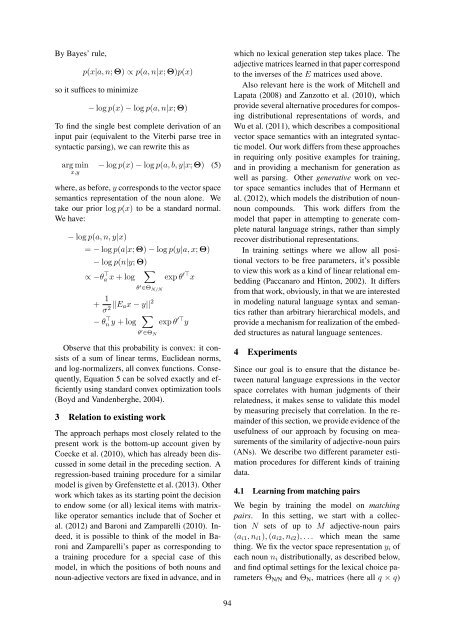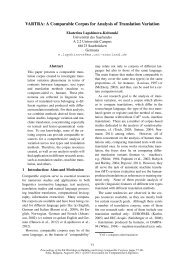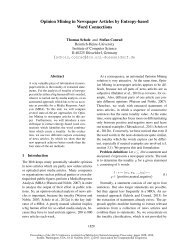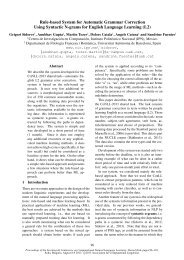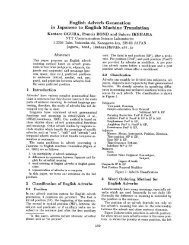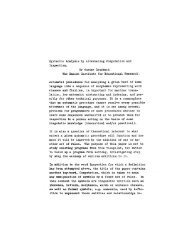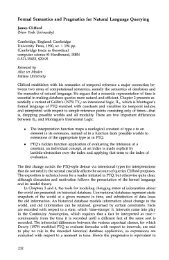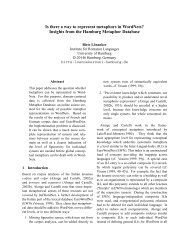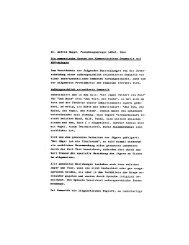Vector Space Semantic Parsing: A Framework for Compositional ...
Vector Space Semantic Parsing: A Framework for Compositional ...
Vector Space Semantic Parsing: A Framework for Compositional ...
Create successful ePaper yourself
Turn your PDF publications into a flip-book with our unique Google optimized e-Paper software.
By Bayes’ rule,<br />
p(x|a, n; Θ) ∝ p(a, n|x; Θ)p(x)<br />
so it suffices to minimize<br />
− log p(x) − log p(a, n|x; Θ)<br />
To find the single best complete derivation of an<br />
input pair (equivalent to the Viterbi parse tree in<br />
syntactic parsing), we can rewrite this as<br />
arg min<br />
x,y<br />
− log p(x) − log p(a, b, y|x; Θ) (5)<br />
where, as be<strong>for</strong>e, y corresponds to the vector space<br />
semantics representation of the noun alone. We<br />
take our prior log p(x) to be a standard normal.<br />
We have:<br />
− log p(a, n, y|x)<br />
= − log p(a|x; Θ) − log p(y|a, x; Θ)<br />
− log p(n|y; Θ)<br />
∑<br />
∝ −θa ⊤ x + log exp θ ′⊤ x<br />
θ ′ ∈Θ N/N<br />
+ 1 σ 2 ||E ax − y|| 2<br />
− θ ⊤ n y + log ∑<br />
θ ′ ∈Θ N<br />
exp θ ′⊤ y<br />
Observe that this probability is convex: it consists<br />
of a sum of linear terms, Euclidean norms,<br />
and log-normalizers, all convex functions. Consequently,<br />
Equation 5 can be solved exactly and efficiently<br />
using standard convex optimization tools<br />
(Boyd and Vandenberghe, 2004).<br />
3 Relation to existing work<br />
The approach perhaps most closely related to the<br />
present work is the bottom-up account given by<br />
Coecke et al. (2010), which has already been discussed<br />
in some detail in the preceding section. A<br />
regression-based training procedure <strong>for</strong> a similar<br />
model is given by Grefenstette et al. (2013). Other<br />
work which takes as its starting point the decision<br />
to endow some (or all) lexical items with matrixlike<br />
operator semantics include that of Socher et<br />
al. (2012) and Baroni and Zamparelli (2010). Indeed,<br />
it is possible to think of the model in Baroni<br />
and Zamparelli’s paper as corresponding to<br />
a training procedure <strong>for</strong> a special case of this<br />
model, in which the positions of both nouns and<br />
noun-adjective vectors are fixed in advance, and in<br />
which no lexical generation step takes place. The<br />
adjective matrices learned in that paper correspond<br />
to the inverses of the E matrices used above.<br />
Also relevant here is the work of Mitchell and<br />
Lapata (2008) and Zanzotto et al. (2010), which<br />
provide several alternative procedures <strong>for</strong> composing<br />
distributional representations of words, and<br />
Wu et al. (2011), which describes a compositional<br />
vector space semantics with an integrated syntactic<br />
model. Our work differs from these approaches<br />
in requiring only positive examples <strong>for</strong> training,<br />
and in providing a mechanism <strong>for</strong> generation as<br />
well as parsing. Other generative work on vector<br />
space semantics includes that of Hermann et<br />
al. (2012), which models the distribution of nounnoun<br />
compounds. This work differs from the<br />
model that paper in attempting to generate complete<br />
natural language strings, rather than simply<br />
recover distributional representations.<br />
In training settings where we allow all positional<br />
vectors to be free parameters, it’s possible<br />
to view this work as a kind of linear relational embedding<br />
(Paccanaro and Hinton, 2002). It differs<br />
from that work, obviously, in that we are interested<br />
in modeling natural language syntax and semantics<br />
rather than arbitrary hierarchical models, and<br />
provide a mechanism <strong>for</strong> realization of the embedded<br />
structures as natural language sentences.<br />
4 Experiments<br />
Since our goal is to ensure that the distance between<br />
natural language expressions in the vector<br />
space correlates with human judgments of their<br />
relatedness, it makes sense to validate this model<br />
by measuring precisely that correlation. In the remainder<br />
of this section, we provide evidence of the<br />
usefulness of our approach by focusing on measurements<br />
of the similarity of adjective-noun pairs<br />
(ANs). We describe two different parameter estimation<br />
procedures <strong>for</strong> different kinds of training<br />
data.<br />
4.1 Learning from matching pairs<br />
We begin by training the model on matching<br />
pairs. In this setting, we start with a collection<br />
N sets of up to M adjective-noun pairs<br />
(a i1 , n i1 ), (a i2 , n i2 ), . . . which mean the same<br />
thing. We fix the vector space representation y i of<br />
each noun n i distributionally, as described below,<br />
and find optimal settings <strong>for</strong> the lexical choice parameters<br />
Θ N/N and Θ N , matrices (here all q × q)<br />
94


